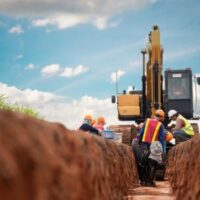Why is Construction Excavation Work So Dangerous?

The construction industry has a high rate of worker injuries and deaths, and construction workers are routinely exposed to hazards that can cause serious and life-threatening injuries. While the whole of the construction industry poses more injury risks than many other industries, some types of jobs are more dangerous than others. Indeed, within the construction industry, excavation and trenching work is among the most hazardous and deadly. According to Safety and Health Magazine, construction workers are nearly always the employees who are injured or killed in excavation accidents. Between 2011 and 2022, construction workers accounted for about 85 percent of all excavation fatalities and 90 percent of all nonfatal excavation accidents.
Why is excavation work so dangerous? Our Maryland construction accident and workers’ compensation lawyers can tell you more.
Nature of Excavation Work is Hazardous
Excavation work itself, by its nature, is hazardous. As the Occupational Safety and Health Administration (OSHA) explains, excavation involves creating “any man-made cut, cavity, trench, or depression in the earth’s surface formed by earth removal.” There are different types of excavations, and trenches are one such type of excavation, defined by their narrow width.
In order to remove large quantities of earth for the purpose of creating trenches, cavities, and other major cuts into the earth, extremely heavy machinery is required. Heavy machinery is often involved in severe construction site injuries such as struck-by accidents and traumatic amputations. In addition to using heavy machinery, workers must perform work within the excavated areas, which are often at risk of caving in if proper precautions are not taken.
Dangers of Cave-Ins
According to OSHA, “cave-ins post the greatest risk and are more likely than some other excavation-related incidents to result in worker fatalities.” Why are cave-ins so deadly? OSHA explains something that many people, including other types of construction workers, may not realize: even one cubic yard of soil weighs as much as a motor vehicle, and cave-ins often involve the disruption of much more than one cubic yard of soil. When workers are within an excavated site where a cave-in occurs, their experience is akin to being crushed by multiple motor vehicles at once.
Safety and Training
Safety measures and proper training are essential to prevent all construction accidents. In excavation work, proper training is especially crucial. Excavation work requires a “competent person,” according to OSHA, who can properly classify soil, inspect protective systems, and monitor the site and equipment. The type of soil determines what makes excavation work safe.
When cave-ins and other excavation accidents result in nonfatal and deadly injuries, the injured worker or their survivors may be eligible for workers’ compensation benefits regardless of fault or negligence.
Contact a Maryland Workers’ Compensation Attorney
If you were seriously injured in an excavation and trenching accident on a construction site, or if you lost a loved one in a deadly excavation accident, it is important to seek legal help as soon as possible. Excavation and trenching work is extremely dangerous, and a seemingly minor mistake can result in worker deaths. One of the experienced Maryland construction worker injury attorneys at the Law Offices of Steinhardt, Siskind and Lieberman, LLC can speak with you today about seeking workers’ compensation benefits in the aftermath of a serious excavation accident on a construction site. Contact us today for more information.
Sources:
safetyandhealthmagazine.com/articles/25402-trenching-and-excavations-deaths-rose-160-in-2022-cpwr#:~:text=Construction%20workers%20accounted%20for%2085,citations%20in%20construction%20in%202023
osha.gov/sites/default/files/publications/osha2226.pdf


